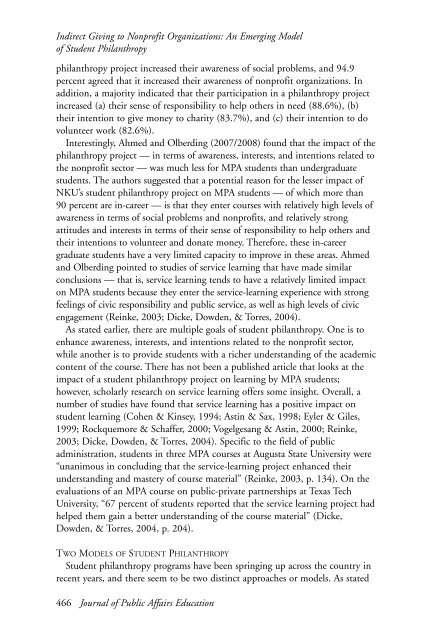JOURNAL OF PUBLIC AFFAIRS EDUCATION - National ...
JOURNAL OF PUBLIC AFFAIRS EDUCATION - National ...
JOURNAL OF PUBLIC AFFAIRS EDUCATION - National ...
Create successful ePaper yourself
Turn your PDF publications into a flip-book with our unique Google optimized e-Paper software.
Indirect Giving to Nonprofit Organizations: An Emerging Model<br />
of Student Philanthropy<br />
philanthropy project increased their awareness of social problems, and 94.9<br />
percent agreed that it increased their awareness of nonprofit organizations. In<br />
addition, a majority indicated that their participation in a philanthropy project<br />
increased (a) their sense of responsibility to help others in need (88.6%), (b)<br />
their intention to give money to charity (83.7%), and (c) their intention to do<br />
volunteer work (82.6%).<br />
Interestingly, Ahmed and Olberding (2007/2008) found that the impact of the<br />
philanthropy project — in terms of awareness, interests, and intentions related to<br />
the nonprofit sector — was much less for MPA students than undergraduate<br />
students. The authors suggested that a potential reason for the lesser impact of<br />
NKU’s student philanthropy project on MPA students — of which more than<br />
90 percent are in-career — is that they enter courses with relatively high levels of<br />
awareness in terms of social problems and nonprofits, and relatively strong<br />
attitudes and interests in terms of their sense of responsibility to help others and<br />
their intentions to volunteer and donate money. Therefore, these in-career<br />
graduate students have a very limited capacity to improve in these areas. Ahmed<br />
and Olberding pointed to studies of service learning that have made similar<br />
conclusions — that is, service learning tends to have a relatively limited impact<br />
on MPA students because they enter the service-learning experience with strong<br />
feelings of civic responsibility and public service, as well as high levels of civic<br />
engagement (Reinke, 2003; Dicke, Dowden, & Torres, 2004).<br />
As stated earlier, there are multiple goals of student philanthropy. One is to<br />
enhance awareness, interests, and intentions related to the nonprofit sector,<br />
while another is to provide students with a richer understanding of the academic<br />
content of the course. There has not been a published article that looks at the<br />
impact of a student philanthropy project on learning by MPA students;<br />
however, scholarly research on service learning offers some insight. Overall, a<br />
number of studies have found that service learning has a positive impact on<br />
student learning (Cohen & Kinsey, 1994; Astin & Sax, 1998; Eyler & Giles,<br />
1999; Rockquemore & Schaffer, 2000; Vogelgesang & Astin, 2000; Reinke,<br />
2003; Dicke, Dowden, & Torres, 2004). Specific to the field of public<br />
administration, students in three MPA courses at Augusta State University were<br />
“unanimous in concluding that the service-learning project enhanced their<br />
understanding and mastery of course material” (Reinke, 2003, p. 134). On the<br />
evaluations of an MPA course on public-private partnerships at Texas Tech<br />
University, “67 percent of students reported that the service learning project had<br />
helped them gain a better understanding of the course material” (Dicke,<br />
Dowden, & Torres, 2004, p. 204).<br />
TWO MODELS <strong>OF</strong> STUDENT PHILANTHROPY<br />
Student philanthropy programs have been springing up across the country in<br />
recent years, and there seem to be two distinct approaches or models. As stated<br />
466 Journal of Public Affairs Education

















